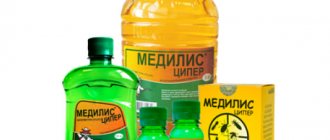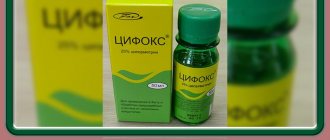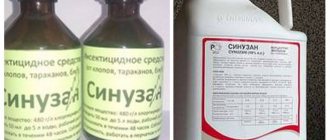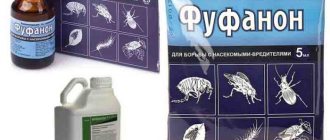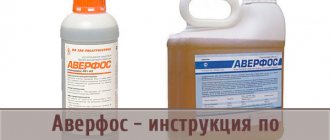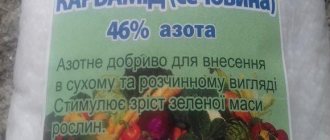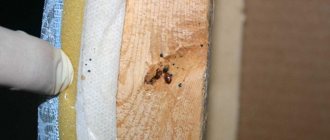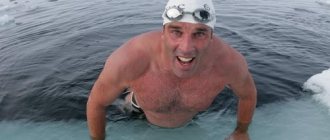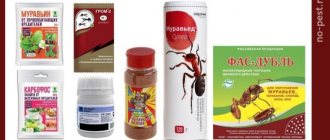Instructions for use of Medilis
The product is used to treat residential and non-residential premises, territories, boarding houses, sanatoriums, and medical institutions against harmful insects. It is used in agriculture to control crop pests, applied to clothing to prevent tick bites, and can be used to get rid of lice and fleas. You need to use insectoacaricide carefully so as not to harm yourself, children, or pets. To do this, it is important to strictly follow the instructions for use.
Composition and release form
The insecticide is available in three varieties, each of which has its own composition. There are ready-to-use products on sale, but there are also those that require dilution with water:
| Type of drug | Active substance | Auxiliary components | Release form |
| Antiklop | Permethrin, cypermethrin, tetramethrin | Organic solvent | Container with spray (spray) |
| Zipper | Cypermethrin (25%) | Emulsifiers, fragrance | Plastic container 50, 500 mm or in ampoules of 1 ml |
| Super | Fenthion (24%) | Synergistic substances that enhance the activity of fenthion | Glass or plastic container 50, 500 ml |
Mechanism of action of the drug
The effect of the product on parasites depends on the main active ingredient. The active component of the Super drug is fenthion, a synthetic oily substance with a garlicky odor. Fenthion inhibits the vital functions of insects, adversely affecting cholinesterases - enzymes that stimulate the transmission of nerve impulses between neurons. The substance continues its effect for 1–2 months after surface treatment and is resistant to ultraviolet light.
Cypermethrin, which is part of Medilis Antiklop and Cyper, has a slightly different effect. This substance is a pyrethroid, and enters the parasite’s body in two ways - through the outer integument or through digestion. Cypermethrin attacks the pest’s nervous system because it causes depolarization of cell membranes, which leads to a slowdown in the flow of sodium ions. This process leads to the occurrence of synaptic disorders that immobilize the insect.
Indications
The insecticide is active against bedbugs, cockroaches, ants, fleas, wasps, flies, mosquitoes and their larvae. The drug is used to prevent bites of ixodid ticks, which transmit encephalitis and borreliosis. This product is used to treat areas and premises to destroy scabies mites and the larvae of dangerous insects. A variety of the drug Super is also used against various types of lice - head, pubic, and clothing.
Composition and concentration
The release form of Medilis Cyper is an emulsion. Active ingredient: cypermethrin. The product is a professional product and the concentration of cypermethrin in the emulsion is 25%. To treat the area, Medilis Cyper must be diluted. The drug is used not only against ticks, but also against any other insects that may be on your personal property or in the house:
- cockroaches;
- various types of ticks;
- fleas;
- ants;
- vile;
- wasps.
Since the concentration of insectoacaricide in the original packaging is very high, the drug must be diluted according to the instructions. The latter provides different percentages of concentrate and water depending on the type of parasite. The concentration of the anti-tick product also depends on the height of the grass in the treated area.
An analogue of “cyper” is Medilis Super, but its active ingredient is fenthion . It is used to treat premises against lice, fleas, cockroaches and other synanthropic parasites.
Directions for use and dosage
Super and Ziper are used diluted and applied by spraying. Before starting to work with the drug, you must wear rubber gloves, and after finishing the procedure, throw them away and wash your hands with soap. The concentration of the finished solution depends on what pest is being combated. After adding the drug, the liquid should be shaken well for 5 minutes.
Medilis Super
If you need to get rid of lice, Super is suitable. From 1 ml of the product (1 ampoule) mixed with 119 ml of water, a solution with a concentration of the active substance of 0.2% is obtained. Apply the prepared concentrate to the scalp using a cotton swab and rinse with shampoo after 20 minutes. Then rinse your hair with an acidic solution (mix a glass of 9% vinegar with 200 ml of water), comb with a fine comb to remove nits and dead insects. Repeat hair treatment after 7–10 days. Do not use more than 2 times in 30 days.
To destroy body lice, it is advisable to treat the patient’s clothing. To do this, things need to be soaked for 20 minutes in water to which a 2% aqueous emulsion of the drug has been added. For 1 kg of dry laundry you will need 2.5 liters of solution. After this, rinse the laundry and soak again in 3 liters of hot water (80–85 °C) with the addition of 3 tbsp. l. soda and 15 g of laundry soap, then wash as usual.
To kill bedbugs, you should prepare a solution - take 5 ml of product per 995 ml of water. To prevent pest infestation, you can use a weaker concentration - 2 ml of the drug per 998 ml of liquid. It is better to treat the bed, mattress, and bed linen by boiling or disinfecting and washing in the manner indicated above. A more concentrated solution will help eliminate cockroaches - 15 ml of the drug per 1 liter of water. You can treat walls, floors, gaps between the wall and baseboard, and exhaust grilles.
- Hot flashes in women - causes and treatment for symptoms
- Throbbing pain in the head - causes and treatment
- Burning in the intimate area in women
Medilis Cyper
This product is not suitable for eliminating lice; otherwise, the concentrate is diluted in the same way as Super. The instructions indicate the following proportions:
- for treating clothing to prevent ixodid tick bites - 5 ml of product per 995 ml of water;
- to destroy flies (imago), cockroaches, fleas, wasp nests, hornets, it is necessary to dilute 4 ml of the drug in 996 ml of liquid;
- ants, bed bugs, mosquitoes, mosquitoes - take 2 ml of insecticide per 998 ml of water.
Types of ticks for which Medilis Cyper is used
The product is used against birth ticks:
- ixodes (Ixodes);
- rhipicephalus (Rhipicephalus);
- dermacentor (Dermacentor);
- hemaphysalis (Haemaphysalis).
Externally, these animals are similar, since they belong to the same order of ixods (Ixodida). The parasites are distinguished by their resistance to cypermethrin: for ixodidae the dose is 2 times less than for the other three genera.
special instructions
When working with insecticide, it is important to follow safety rules - use a protective suit (if large areas are to be treated), gloves, goggles, and a respirator. Other special instructions:
- Discard the container in which the solution was prepared after use.
- Disinfection of the room is carried out with the windows open; food must be removed from the room in advance. After finishing the treatment, ventilate the home for half an hour.
- The product has low toxicity for warm-blooded animals, but it is better to perform the procedure in the absence of pets. If there is an aquarium in the room, you need to cover it with a lid and turn off the aerator.
Side effects and contraindications
During disinfection, pregnant women, persons under 18 years of age, and those for whom contact with pesticides is contraindicated should not be present in the room. In case of poisoning by vapors of a substance, the following manifestations are possible:
- bitter taste in the mouth, salivation;
- nausea, aggravated by smoking or eating;
- dizziness, headache;
- abdominal pain, dyspeptic symptoms;
- general weakness.
With such symptoms, you need to take the victim out into fresh air and give him a drink of water. If part of the emulsion gets into the stomach, you need to drink an absorbent - activated carbon (10-20 tablets), Enterosgel or Atoxil. If the product gets into your eyes, be sure to rinse them with water and drip Albucid. After providing first aid, show the patient to the doctor.
Analogs
Instead of Medilis, you can use another insect control agent. The following drugs are effective:
- Veda is a shampoo designed to remove lice and nits. It contains permethrin, which paralyzes insects by striking their nervous system.
- Medifox is a permethrin-based product for the treatment of head lice and scabies. The drug is diluted with water and applied to the skin or hair using a tampon.
- Nyuda is an oily solution whose active substance is dimethicone. This compound is liquid silicone; it envelops insects in a dense shell, contributing to their suffocation.
- Para Plus is a multi-component aerosol against lice and nits. Contains permethrin, malathion and peronyl butoxide, which work in synergy, enhancing each other's effects.
- Paranit is a head lice shampoo based on dimethicone, which has the effect of dehydrating and suffocating parasites.
- Parasidosis is a repellent for repelling insects, used to prevent the appearance of lice in children and adults. Contains ethyl butylacetylaminopropionate, applied by spraying onto hair.
- Full Marx is a remedy for eliminating pediculosis (head lice). Contains cyclomethicone and isopropyl myristate. Leads to dehydration of insects and their death.
REGISTER OF DISASTERING PRODUCTS
print version
MEDILIS-Des
LLC "Laboratory MediLIS", Russia All disinfectants from this Manufacturer...
| MEDICLOR MEDILIS-Des | Medilis-3 DV DEZ MEDILIS-asept |
LLC "Laboratory MediLIS", Russia All disinfectants of this Recipient...
| MEDICLOR MEDILIS-Des | Medilis-3 DV DEZ MEDILIS-asept |
No. 1-12/10 of 2011
HOUR, Tertiary amine, Auxiliary components >
Alkyldimethylbenzylammonium chloride (ADBACH) + didecyldimethylammonium chloride 10.1%, Dodecyldipropylene triamine 3.8%, Auxiliary components
Stated hydrogen ion activity (pH) : 8.0 to 10.0
liquid concentrate - 0.05 dm3, 10 dm3;
in packaging - 5 years, in working solution - 28 days
Price range for disinfectants: from 645.46 rubles. for 1l/kg up to 677.73 rub. for 1l/kg. go to all offers
The average cost of a disinfectant per 1 liter/kg is 1172 rubles
The average value for 1 l/kg of concentrate is determined as the arithmetic average for 1 l/kg from several suppliers in different packaging. The cost calculation takes into account only packaging of at least 0.5 l/kg. If there is only one offer, this offer is considered average, provided that its packaging is at least 0.5 l/kg.
The cost of 1 liter of working solution is calculated based on the average cost of 1 liter/kg of concentrate.
| Mode | Conc/exp | Cost of 1 liter of working solution, rub. |
| Disinfection of surfaces by bacteria (excluding tuberculosis) | 0.01% / 60 min. 0.05% / 30 min. 0.1% / 15 min. 0.25% / 5 min. | 0.12 0.59 1.17 2.93 |
| Disinfection of surfaces for viral infections | 0.1% / 60 min. 0.25% / 30 min. 0.5% / 15 min. 15 minutes. | 1.17 2.93 5.86 11.72 |
| Disinfection of surfaces for candidiasis | 0.25% / 30 min. 0.5% / 15 min. 15 minutes. | 2.93 5.86 11.72 |
| Disinfection of surfaces against dermatophytes | 0.25% / 90 min. 0.5% / 60 min. 1% / 30 min. 1.5% / 15 min. 2% / 5 min. | 2.93 5.86 11.72 17.58 23.44 |
| Disinfection of surfaces for tuberculosis | 0.25% / 60 min. 0.5% / 30 min. 1% / 15 min. 1.5% / 5 min. | 2.93 5.86 11.72 17.58 |
| Disinfection of medical devices for bacterial, viral infections and candidiasis | 0.25% / 60 min. 0.5% / 30 min. 1% / 15 min. 1% / 20 min. 2% / 10 min. | 2.93 5.86 11.72 11.72 23.44 |
| Disinfection combined with PSO medical devices for bacterial, viral infections and candidiasis | 0.1% / 60 min. 0.25% / 45 min. 0.5% / 20 min. 1% / 15 min. | 1.17 2.93 5.86 11.72 |
| Pre-sterilization cleaning of medical devices | 0.01% / 30 min. | 0.12 |
| TLD endoscopes | 3% / 30 min. 4% / 15 min. 6% / 5 min. | 35.16 46.88 70.32 |
| Sterilization of medical devices | No mode | — |
| Blood disinfection | 0.5% / 90 min. 1% / 60 min. 2% / 30 min. | 5.86 11.72 23.44 |
| Disinfection of sputum | 0.5% / 90 min. 1% / 60 min. 2% / 30 min. | 5.86 11.72 23.44 |
| Disinfection of feces | 0.5% / 90 min. 1% / 60 min. 2% / 30 min. | 5.86 11.72 23.44 |
View all application modes...
| Mode of application | Volume | Unit change |
| Consumption of the product on the surface using the “Quasar” irrigation method | 150 | ml/m2 |
| Consumption of the product on the surface by irrigation with a hydraulic remote control | 300 | ml/m2 |
| Consumption of the product on the surface by wiping | 100 | ml/m2 |
Does not cause corrosion of metals; Preservation of properties during freezing/thawing; Does not discolor fabrics; Does not capture organic contaminants; Not aggressive towards processing objects
when administered into the stomach - 3; when applied to the skin - 4; working solution - 4
Bacteria - Mycobacterium tuberculosi, Anaerobic infections, Pathogens of nosocomial infections, Gram-negative bacteria, Gram-positive bacteria;
Viruses -
Adenoviruses, SARS, HIV, Hepatitis C, Hepatitis A, Hepatitis B, Herpes, Influenza, Parainfluenza, Parenteral hepatitis, Poliomyelitis, Other pathogens of ARVI, Bird flu (H5N1), Rotaviruses, Swine flu (H1N1), Enteral hepatitis, Enteroviruses;
Causative agents of parasitic diseases -
Cysts, oocysts of protozoa, eggs and larvae of helminths, eggs and larvae of pinworms;
Pathogenic fungi -
Dermatophyton, Candida, Molds;
Sporicidal properties; Cleaning properties; Deodorizing properties;
Obstetric hospitals, healthcare facilities, Clinical laboratories, Bacteriological laboratories, Children's institutions (kindergartens, schools, etc.), Penitentiary institutions, Infectious outbreaks, Catering enterprises, Food trade enterprises, Consumer markets, Communal facilities (baths, swimming pools, hotels, public toilets, etc.), Hairdressers, Beauty and (or) massage salons, Laundries, Sanitary transport, Neonatology departments, Diagnostic laboratories, Virology laboratories, PCR laboratories
Anesthetic equipment, Pharmaceutical utensils, Storage tanks of self-contained toilets, Underwear, Bed linen, Household air conditioners, Ventilation filters, Indoor air, Air ducts, Rotating dental instruments, Patient discharge (urine, feces, sputum), Flexible endoscopes, Rigid furniture, Rigid endoscopes, Filling of disinfection barriers, disinfectants, disinfection mats, Toys, medical devices made of metals, rubbers based on natural and silicone rubber, glass, plastics, conventional medical devices, disposable medical devices before disposal, Instruments for endoscopes, Dental instruments, Surgical instruments, Blood, Rooftop air conditioners, Couveses, Laboratory glassware, Honey. waste from textile materials (cotton and gauze swabs, gauze, bandages), Sputum, Urine, Waste collection equipment, garbage chutes, Upholstered furniture, Floor coverings, Anesthesia equipment, Upholstery fabrics, Shoes, Disposable tableware, Food waste, Spittoons, Surfaces in premises, Surfaces of instruments and apparatus, Dishes from secretions, Soil, Dishwashing items, Personal hygiene items, Furnishings, Patient care items, Adaptations for incubators, Vomit, Rubber and polypropylene mats, Sanitary equipment, Saliva ejectors , Flush water, Split systems, multi-zone split systems, Sports equipment, Tableware, Dental materials (alginate, silicone, polyester resin impressions, denture blanks, articulators), Dental suction systems, Food transport, Cleaning equipment, Feces, Endoscopic rinses
View the registration certificate of the disinfectant on the official website fp.crc.ru
, Russia…
Suppliers' offers for disinfectant MEDILIS-Dez (price is current today)
| Unit volume | Packaging characteristics | Per item | For 1l/kg of concentrate | Supplier of the goods | Contacts | Supplier price date |
| 1 l | 1172.00 rub. | Disinfectant store | tel. | 23.04.2015 |
Medilis price
The cost of Medilis depends on the region, the volume of the container with the drug, and the store. The type of insecticide matters - Antiklop, Ziper, Super. In Moscow you can purchase the product at the following prices:
| Drug name | Capacity volume, cost | ||
| 50 ml/rubles | 250 ml/rubles | 500 ml/rubles | |
| Antiklop | — | 385–460 | — |
| Zipper | 190–230 | — | 1200–1500 |
| Super | 190–250 | — | 1300–1550 |
